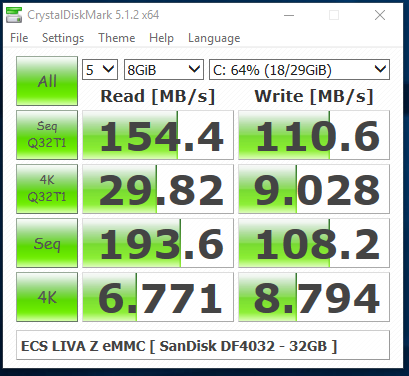ECS LIVA Z Fanless Dual-LAN Apollo Lake UCFF PC Review
by Ganesh T S on March 30, 2017 8:00 AM ESTNetworking and Storage Performance
Networking and storage are two major aspects which influence our experience with any computing system. This section presents results from our evaluation of these aspects in the ECS LIVA-ZN33. On the storage side, one option would be repetition of our strenuous SSD review tests on the drive(s) in the PC. Fortunately, to avoid that overkill, PCMark 8 has a storage bench where certain common workloads such as loading games and document processing are replayed on the target drive. Results are presented in two forms, one being a benchmark number and the other, a bandwidth figure. We ran the PCMark 8 storage bench on selected PCs and the results are presented below. Note that these benchmarks were run with the SSD as the primary drive andthe eMMC mounted as a secondary drive. PCMark 8 allows specification of the logical drive for benchmarking. The storage workload was run twice (once for the SSD and once for the eMMC partitions). Both results are presented in the graphs below.


As expected, eMMC performance can't obviously match up to the SSD. However, as the storage subsystem score shows, the difference is not acute for light home / office use.
We also ran CrystalDiskMark 5.1.2 x64 in the eMMC-only configuration to get some best-case numbers for different artificial workloads.
On the networking side, we restricted ourselves to the evaluation of the WLAN component. Our standard test router is the Netgear R7000 Nighthawk configured with both 2.4 GHz and 5 GHz networks. The router is placed approximately 20 ft. away, separated by a drywall (as in a typical US building). A wired client is connected to the R7000 and serves as one endpoint for iperf evaluation. The PC under test is made to connect to either the 5 GHz (preferred) or 2.4 GHz SSID and iperf tests are conducted for both TCP and UDP transfers. It is ensured that the PC under test is the only wireless client for the Netgear R7000. We evaluate total throughput for up to 32 simultaneous TCP connections using iperf and present the highest number in the graph below.

In the UDP case, we try to transfer data at the highest rate possible for which we get less than 1% packet loss.

All the considered PCs use a 1x1 WLAN configuration. The Intel AC3165 performs up to its potential and the antenna placement / plastic chassis ensures that the bandwidth numbers for the ECS LIVA Z are quite good compared to the other systems in the comparison list.











30 Comments
View All Comments
Namisecond - Monday, April 3, 2017 - link
It probably started life in design as one, but things probably didn't work out... :)Meteor2 - Friday, March 31, 2017 - link
Why doesn't Anandtech use a common benchmark suite across all classes of computer? Couldn't you at least run Geekbench 4 and Jetstream (via Chrome) on everything? I know there are arguements for and against all benchmarks -- I wish you'd run a straight Handbrake x264 to x265 transcode of 1080p material on everything you can -- but I think GB4 and Jetstream minimise inter-platform differences and have strong real-world relevance.Teknobug - Friday, March 31, 2017 - link
Really... are we still using 2C/2T systems in 2017?rocky12345 - Friday, March 31, 2017 - link
Nice review looks like a nice little media station hooked to a TV. ECS I did not even know they were still around. Do they still make Mother boards? If I remember right they used to make lower end mother boards back in the day.Arbie - Friday, March 31, 2017 - link
Yeah, ECS motherboards were the ones stacked to the ceiling on Frys Electronics "Returns" bench.Death666Angel - Saturday, April 1, 2017 - link
I had the legendary ECS K7S5A which had SD RAM and DDR RAM simultaneously. It had a SiS 735 chipset, which was finicky, but cheap. Oh the days of competing chipsets.DocNo - Friday, March 31, 2017 - link
Ugh - why do vendors put two NICs in these things that are based on anything other than Intel chipsets? Realtek may be OK for desktop use but suck for heavy network loads. I could use a boatload of these with pfSense. And they may work fine, but so many issues with crappy Realtek and Broadcom NICs have me to the point where I don't even want to bother trying :pItselectric - Saturday, April 1, 2017 - link
They've gotten better; not intel; but still better.CharonPDX - Monday, April 3, 2017 - link
Seems like an odd choice to not include even ONE USB port on the back. I mean, replace the mini DisplayPort with a USB type C port, at least. Then the user can choose between using it as a display or for peripherals. (Since 99% of people wanting to use it for display would need to use an adapter anyway.) Heck, then it would go great with a USB-C-equipped DisplayPort-protocol monitor, like the LG UltraFine 4K Display.indianajames - Monday, April 3, 2017 - link
Man.... I was really into this as a replacement for my circa 2012 Foxconn NT-A3500 HTPC setup now that I upgraded to a 4k/HDR TV..... until I noticed it doesn't have a HDCP 2.2 capable HDMI 2.0 port.... kinda kills it...